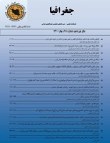An Analysis of the Explanatory Components of Urban Poverty in Esfarayen
Dikes are internal igneous structures that have penetrated their host rocks in the form of sheets. These structures are mostly caused by the ascent of magma in fractures caused by regional tensile stresses or volcanic rifts. Dikes are classified based on different criteria such as origin and formation method. Some of them are known as sheeted dikes in ophiolitic complexes. These dikes are formed in ophiolitic complexes and in the place of magma ascent channel forming pillow lavas. Some dikes in volcanic areas play a role as dikes feeding volcanic zones or dacite and rhyolitic domes. This type of dikes is called feeder dikes. Another group of them penetrated in a relatively wide area inside the fractures that were formed under the influence of a specific tectonic regime and massively in one area, which are called swarm dikes, which are the subject of this discussion. It is an article. In swarm dikes, usually their frequency distribution in the region is more than 2 dikes per square kilometer. The formation of swarm dikes is due to the action of the tensile tectonic regime in the earth's crust, before their replacement. In this case, the abundance of dikes is directly related to the maximum amount of tensile stress. Due to the existence of different ophiolitic and volcanic regions in Iran, as well as the occurrence of different orogenic phases and the application of different tectonic regimes in different geological periods in the land of Iran, different volcanic dikes were formed in its structural land areas. Of course, no comparative research has been done to compare these geomorphological complications. Therefore, in this article, the researcher seeks to introduce more swarm dikes, compare and examine their general characteristics and their formation mechanism, with references from the dikes in the north of Saveh, in the Urmia-Dakhtar zone, and the dykes of Delbar and Zarigan regions in Central Iran.
In this research, firstly, information was collected about the nature and mechanism of swarm dikes, and then a relatively large number of searches were conducted in written sources, especially researches and theses, about swarm dikes in Iran. The statistical population of this research is all the swarm dikes of Iran, which were chosen from among the types of these dikes due to the abundance of dikes in two geo-structural zones, Urmia-Dakhtar and Central Iran. And finally, a comparative study related to the general characteristics, time of formation and comparison of the formation mechanism and geodynamic model of these dikes with the formation mechanism and geodynamic model of other typical swarm dikes of the world has been done.
From the geodynamic point of view, the swarm dikes in the north of Saveh follow a relatively regular and parallel linear arrangement, which is generally in the same direction as the general trend of the faults in the region and has a general trend of northwest, west-southeast, east. According to the studies of Ernst et al. (1999), the swarm dikes in North Saveh, which is a part of the Urmia-Dakhter structural zone dikes, can be considered swarm type IV dikes. which are caused by the creation of regional stress areas. According to Huo's (2012) studies, swarm dikes in Delbar area can be considered similar to parallel dikes, which they call parallel Fuji dykes with a linear pattern in a range They have been formed with a relatively limited extent and under the influence of regional stresses resulting from the primary back-arc caftic tension caused by the subduction of the Neotethys oceanic lithosphere under the continental lithosphere of central Iran. From the geodynamic point of view, swarm Zarigan dikes follow an irregular linear arrangement. shows that there is no significant relationship between the trend of faults in the studied area and the direction of their establishment (northwest, west-southeast, east). According to the studies of Ernst et al. (1999), these swarm dikes, which are part of the swarm dikes of the structural zone of Central Iran, are similar to V-type swarm dikes. which are caused by the creation of regional tension areas.
There are many geomorphological phenomena known as mass dikes in different geological zones of Iran. which are different from each other in terms of age of formation, formation mechanism and type of constituent rocks. Comparative studies of Swarm dikes in two structural zones of Urmia--Dokhtar and Central Iran show that their age ranges from Cambrian to Oligomiocene and their lithological composition varies from basic to acidic rocks. And in the three studied areas, it mainly includes andesite, basaltic, gabbro, gabbro diorite and alkali gabbro rocks. Geological stresses affecting their formation have been different in different regions. According to Ernst's classification, Swarm dikes in North Saveh are classified as type IV dikes and Swarm dikes in Delbar and Zarigan area are classified as type V dikes. And according to Hou's classification, the dikes of all three regions follow a linear pattern. The mechanism of formation of dikes in all three regions is related to subduction and ascent of magma in fractures caused by subduction.
- حق عضویت دریافتی صرف حمایت از نشریات عضو و نگهداری، تکمیل و توسعه مگیران میشود.
- پرداخت حق اشتراک و دانلود مقالات اجازه بازنشر آن در سایر رسانههای چاپی و دیجیتال را به کاربر نمیدهد.



